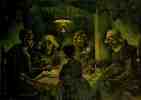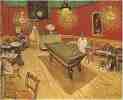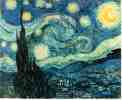
Postimpressionist artist Vincent van Gogh (van go, Dutch vinsent` van khokh)
was the son of a Dutch pastor, born in Netherlands, placed the Paris on the top
of the world of art. With his uncle Vincent van Gogh went to the business of art
dealership with the Goupil and Company at The Hague, antagonizing customers
until he was dismissed. His brief, confused, violent and tragic life was spent
in religious lunacy (during a visit by his friend Gauguin van Gogh cut off on of
his own ears). His difficult, contradictory personality was rejected by the
women he fell in love with, and his few friendships usually ended in bitter
arguments. In 1880 his brother Theo, an artist who was living in Paris, agreed
to finance him to become a painter. For the next six years he spent taking
lessons from his uncle Anton Mauve.
In 1886, he moved to Paris and there people saw his lighter palette and pure
colors. During his life span, his work was represented in two very small
exhibitions and two larger ones. Only one of Van Gogh's paintings was sold while
he lived. In the spring of 1889 van Gogh was committed to an asylum at
Saint-Remy, where he continued to paint. He left the asylum in May of 1890 and
stayed with his brother in Paris for a while and then went to stayed with Dr
Gachet. The great majority of the works by which he is remembered were produced
in this period of 29 months of frenzied activity and intermittent bouts with
epileptoid seizures and profound despair that finally ended in suicide by
shooting himself.
|
Early work (Dutch period 1880-85) consists of dark greenish-brown, heavily painted studies of peasants and miners. |
 |
|
The first complete and successful work in new colors. |
 |
|
|
|
||
 |
||
|
|
|
|
 |
||
|
|
||